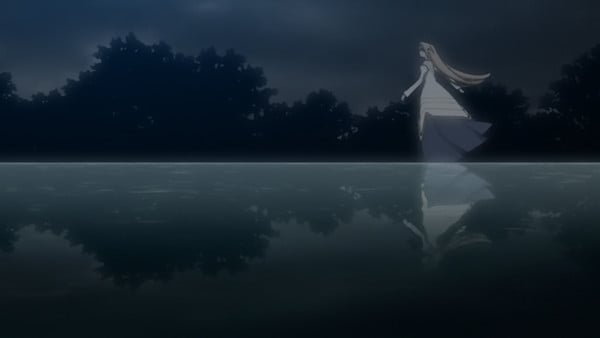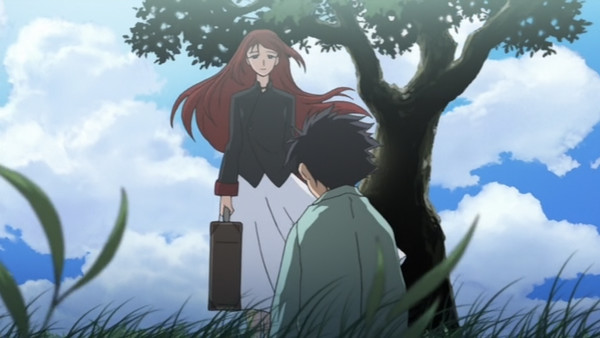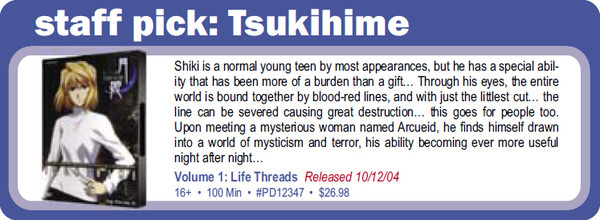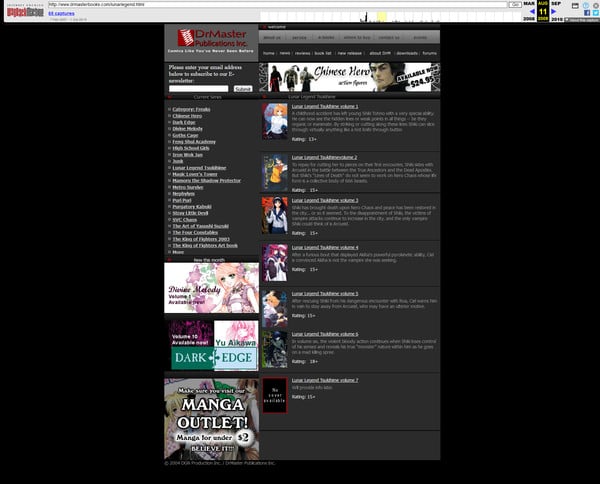Lunar Legend Tsukihime: Revisiting the Anime that 'Doesn't Exist'
by Kennedy,Ask a Tsukihime fan what they think of the hit visual novel's 2003 anime adaptation, and they'll probably say something to the effect of, “What anime? There is no Tsukihime anime!” Indeed, in a series that's spawned countless memes, the joke that there's no Tsukihime anime is still one of the more often repeated ones. And it's hardly a wonder why fans would probably prefer to consider this anime non-existent. Despite the longevity Tsukihime has proven to have, its anime adaptation—Lunar Legend Tsukihime (LLT)—is widely considered to be among the worst visual novel adaptation anime of all time.
Originally a visual novel by Type-Moon, Tsukihime follows Tohno Shiki: a sickly high schooler who, after a near-death experience in his childhood, can see lines that if they're cut across, whatever is cut is destroyed. But now, eight years later, Shiki is once again living with his sister (and two maids, Hisui and Kohaku) in his family's mansion. But the day he moves back in, he has a random, but powerful impulse to brutally dismember a random woman—who, it turns out, is an immensely powerful vampire named Arcueid. To make up for his “killing” her (it takes a considerable amount of her power, but she's able to revive herself), Arcueid recruits Shiki to help her kill another powerful vampire in town.

As an adaptation, Lunar Legend Tsukihime sucks
There's no sugar (blood?) coating it: as an adaptation of its source material, LLT misses the mark completely. Firstly, despite primarily being an adaptation of Arcueid's route, it also tries to work in elements from other routes—elements that make varying levels of sense being there, given the implications that they have for the rest of the story. Admittedly, this isn't an uncommon thing that anime adapting visual novels with multiple routes try to do, but that doesn't make it any less jarring, nor does it make the creation of these Franken stories any better. Furthermore, these additional elements are never unpacked in a meaningful way, making them feel all the more unnecessary.
Similarly, LLT also includes a few original story elements that flat-out aren't in the visual novel, even outside of Arcueid's route. To be clear: the adding of original story elements isn't inherently a flaw. Plenty of anime adaptations have added original elements that have worked to the story's benefit (DEVILMAN crybaby, for example, springs to mind). But the additions made in LLT serve no clear purpose, and feel very transparently like filler meant to kill time in an anime whose pacing is already an issue—but more on that in just a bit.
For now, I'd like to pivot to another of this anime's more highly visible issues: the visuals. Gone is Takeuchi Takashi's style in all its turn-of-the-millennium, technicolor charm and glory, and in are the dull, gray-tinted blobs that the anime gives us. This is further emphasized by animation quality that's serviceable overall, but somehow gets sloppier the longer you look at it.

But without question, the biggest problem with LLT as an adaptation is the removal of Shiki's interiority. Because he narrates the visual novel, the reader walks hand in blood-soaked hand with Shiki as he not-so-gradually descends into madness. His every thought, fantasy, and grisly nightmare is verbally illustrated in painstaking detail. Shiki's ever-crumbling sense of self is an integral part of the story. So without having this context, several key moments are bleached of their original meaning and drama, and much of the horror and tension underscoring the story is gone.
This directly causes further problems with the pacing as well. Because none of those nightmares or monologues that take up so much time in Tsukihime make it to LLT—because LLT is focused more on the external than internal—the speed at which things happen is either at a 1 or 11, with nothing in between. More often than not, things happen at a snail's pace in LLT, to make up for all the time not spent in Shiki's mind. But now and again, these dragging segments get interrupted by fleeting moments where so many things are happening so quickly, or so much information gets thrown at the audience at once, that it's hard to keep up with what's going on and what its significance is. And especially in tandem with all the loose ends left behind by this series (which, to be fair, makes sense; if you're not going to adapt every route, a feeling of incompleteness is inevitable) it makes the whole viewing experience all the more confusing.
Perhaps the most positive thing I can say about LLT as an adaptation is that while it was arguably the worst visual novel adaptation anime of its time, that's probably no longer the case today. For example, in my opinion, that dubious honor now firmly belongs to Dies irae (which aired in Fall 2017), which was so clumsy in its explanations and lore dumps that whilst reviewing the series for ANN, Theron Martin recommended that viewers interested in sticking with the series look on a wiki page to fill in the many blanks left by the anime. As of the time of writing, the average ANN community score of each episode is 3.1 out of 5. Meanwhile, its average score on MyAnimeList is 5.40 out of 10 (for comparison, LLT's is currently 6.82). But while LLT might no longer be the singular worst visual novel adaptation anime, it's without question right up there with titles like Chaos;HEAd and Chaos;Child as solid contenders for the runner-up spot.

And as a standalone experience, it's not worth batting an eye at
LLT's official English release happened at a weird time. While it aired in Japan in Fall 2003, the official English release wouldn't start until October 2004, and end in February 2005. This was well before the first anime adaptation of Type Moon's biggest hit, Fate/stay night (often nicknamed “Deen/Stay Night”), aired in Japan in Winter 2006, and fan translations of the visual novels (either Tsukihime or Fate/stay night) became more widely available. Similarly, although Melty Blood—a Tsukihime fighting game by French-Bread—was out in Japan, it's impossible to point to a precise moment where it started getting traction in English-speaking pockets of the fighting game community, though I couldn't find footage/evidence of any Melty Blood tournaments happening in a predominantly English-speaking country before 2005 (while it's impossible for me to fully verify this for a long list of reasons, the uploader claims that this footage comes from the first Melty Blood tournament held in the US).
In other words, LLT's English language release came out during a time when few people in the market would've known much, if anything, about Tsukihime. It makes reading the reviews from the time an interesting experience, as they're generally uninfluenced by the visual novel, and this anime's many shortcomings as an adaptation. But while they lack the cynical or sarcastic tone more prevalent in later reviews, these earliest reviews—while not terrible—still aren't exactly great, either.
For example, in 2004, Bamboo Dong wrote on ANN about the first volume of the series, “The episodes are slow, and viewers are still largely left in the dark about what's going on, but it's an oddly gripping show nevertheless.” Similarly, AnimeOnDVD's Chris Beveridge wrote, “When the Japanese do vampires, I'm usually pretty interested since there's enough difference and variety to their take on these creatures that it doesn't feel like every single idea has been exhausted. We get some tidbits of this culture in this volume but it's been wrapped around by some very slow pacing, amateurish dialogue, and character interactions that look just plain bad. There are some small highlights here and there, such as the opening sequence and the all too brief action sequences, but eventually, the fog that seems to inhabit this show hit me in much the same way and just left me bored.”

As for me, revisiting this anime today and trying my best to look past its (lack of) quality as an adaptation, it's still unremarkable; it's not good, to be clear, but it's far from the worst that I've seen. Many of the same things that make it abysmal as an adaptation, also contribute toward its being lackluster even in a vacuum: the visuals are lifeless, the story makes little sense, and the pacing makes watching it feel like a slow trudge. Admittedly, however, the soundtrack is nice for what it is, and Arcueid's charm shines through her muted color palette. Overall, if I had to sum up this anime as a standalone experience in a word, it'd just be “forgettable.” It's not good, but it's also not bad in a way that makes it memorably bad if you forget that this is supposed to be an adaptation of a great visual novel. There are so many better vampire anime that you could instead spend your time watching, that it feels pointless to even try listing them all. That being said, if you want some actionable advice from this article, let it be that you should watch Shiki.
Generally, the only way visual novel adaptation anime get forgiveness for being poor adaptations is by at least being a good standalone experience (although more often than not, the better visual novel adaptation anime tend to be good both as adaptations and standalone experiences), and LLT certainly doesn't achieve this, making it a poor experience overall, and far from representative of the quality of the visual novel. It's certainly not the worst anime of all time, and probably not even the worst visual novel adaptation anime out there, but it's still not exactly something I'd readily recommend either for someone interested in dipping their toes into the world of Tsukihime, or to someone who just wants to watch a cool, early-2000s vampire anime.

On the irony of “not existing”
As mentioned earlier, Tsukihime has a complicated relationship with the English language market: The original visual novel never officially came out in English, and the anime came out during a time when few (if anyone) would've known—let alone cared—about it. And as if this wasn't all bad enough by itself, the English language release of Sasakishonen's Tsukihime manga—which Type-Moon co-founder Kinoko Nasu has expressed positive feelings for—had just about everything that can go wrong, well, go wrong.
Originally, the English language translation of the Tsukihime manga, published by ComicsOne, was supposed to start its release in January 2005. But as the phrase “supposed to” might've told you, this didn't end up happening, as it was announced that ComicsOne would no longer be publishing new manga that same January. This allowed for DrMaster to pick up the series. Ultimately, it would be August 2005 before that first volume would finally be released. But then, after releasing only six of the ten volumes of the Tsukihime manga, DrMaster quietly ceased operations sometime in 2009. The license has never been picked up again, so even now—15 years later—it remains officially unfinished (although unofficial, fan translations are widely available).

It's also worth bringing up Melty Blood again. While not all English-language Melty Blood fans have necessarily watched/read/played Tsukihime (or vice-versa for that matter), it's still developed a fan community unto itself. But regardless of whether or not these players have an interest in Tsukihime beyond Melty Blood, the fact remains that it's still Tsukihime characters; it still serves to keep Tsukihime very much around in these fan communities. Predictably, while the first one to get an official English release of any kind was Melty Blood Actress Again Current Code in 2016, Melty Blood's cult success among English language players—who either played using the Japanese or with fan-translated English patches—predates that by several years. Suffice to say, jokes about Melty Blood players being dedicated enough to play in bathrooms and Popeyes parking lots didn't exactly appear out of nowhere.
As of the time of writing, LLT can be streamed on HIDIVE, and its most recent physical re-release was through Sentai in 2015. In other words, for English speakers looking to get into Tsukihime by official means, ironically the anime has been one of the more accessible—more existent, if you will—starting points. Arguably the most, depending on what metrics you want to use (it's rivaled only by Melty Blood Actress Again Current Code and MELTY BLOOD: TYPE LUMINA—which also got an official English language release in 2021). Historically speaking, Tsukihime's presence in English language communities of Japanese media fans has—largely out of necessity—predominantly been a completely fan-operated affair, kept afloat by little more than sheer love of Tsukihime and/or Melty Blood. It's therefore hard to overstate how big a deal Type-Moon's recent decision to (finally) release their visual novels officially in English is, especially now that it's culminated in the releases of A Piece of Blue Glass Moon and a remastered version of Fate/Stay Night. Almost 20 years after the first volume of LLT's DVDs came out, (a remake of) the visual novel that inspired it is finally on global store shelves.
discuss this in the forum (30 posts) |
this article has been modified since it was originally posted; see change history